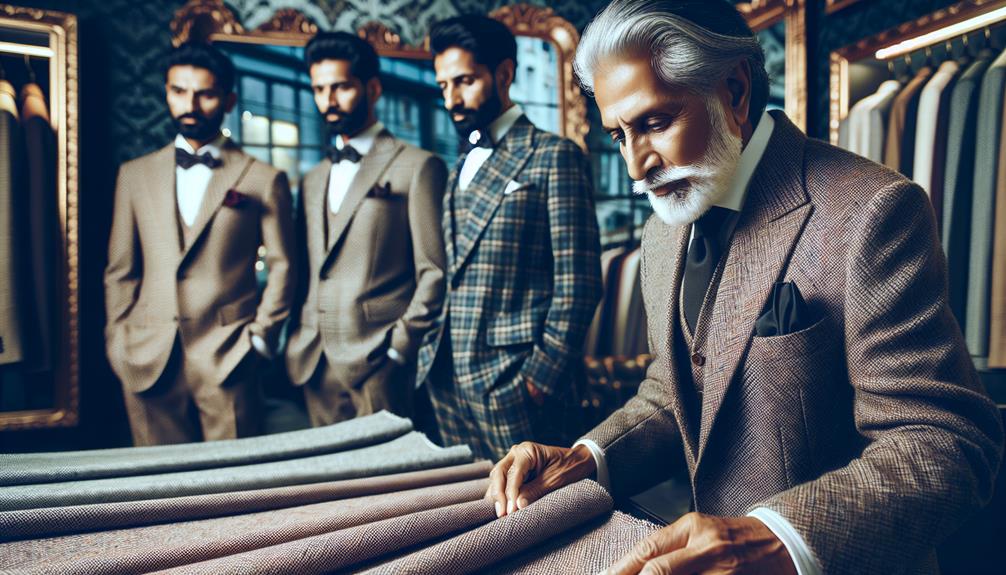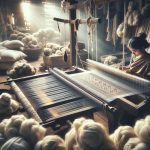I've been mulling over whether investing in a tweed suit is truly worth the hype. Sure, they've got a classic charm and undeniable durability, but is the steep price tag justified? When you think about versatility, a tweed suit can swing from formal to casual with just a few tweaks in accessories. Yet, I find myself questioning if it's adaptable enough for today's fast-paced, varied lifestyles. As someone always on the lookout for value, I can't help but wonder if the benefits really outweigh the cost. What do you think? Is the investment in a tweed suit a smart move or an outdated tradition?
Table of Contents
Key Takeaways
- Tweed suits offer timeless style and versatility, suitable for both formal and casual settings.
- Made from durable wool, tweed suits provide warmth, insulation, and moisture resistance.
- High-quality tweed retains strong resale value and can increase in value over time.
- Maintenance involves dry cleaning and careful storage, ensuring long-lasting wear and appearance.
- Brands like Harris Tweed are noted for their sustainable practices and exceptional craftsmanship.
History of Tweed Suits
Tweed suits first gained popularity in the 19th century, becoming a staple for outdoor sports among the British elite. Let's explore the intriguing world of these suits, focusing on their origins and cultural significance.
The story of tweed begins on the misty isles and highlands of Scotland. The fabric was initially a practical solution for farmers and gamekeepers who needed durable clothing that could withstand harsh weather. However, many origination myths surround tweed, including romantic tales of Scottish widows weaving the fabric by hand to support their families. These stories add a layer of mystique and allure to tweed, elevating it from mere material to a symbol of resilience and ingenuity.
Culturally, the suit's significance skyrocketed when British aristocrats adopted tweed as their leisurewear of choice for hunting, golfing, and other outdoor pursuits. This adoption by the upper class not only solidified its status in the UK but also helped it gain international recognition. Tweed became synonymous with a sophisticated, yet rugged, outdoor lifestyle—an image that continues to resonate around the world today.
Understanding this history isn't just about tracing fashion trends; it's about appreciating how deeply intertwined tweed is with stories of survival, social shifts, and style evolutions.
Material and Durability
Often, when I consider buying a suit, I focus on how well it'll hold up over time, and tweed is renowned for its durability. The fabric origins of tweed trace back to Scotland and Ireland, regions known for their rugged landscapes and challenging weather. This historical context isn't just trivia—it explains why tweed's toughness is practically legendary.
Tweed's endurance comes from its unique weave techniques. It's typically made from wool, and the fibers are tightly woven in a way that creates a dense, robust material. This isn't just any woven fabric; the process includes different types of weaves like twill, herringbone, and plain weave, each contributing to the fabric's strength and longevity. Because of this intricate weaving, tweed suits resist wear and tear much better than most materials.
Moreover, the natural oils in the wool make tweed moisture resistant and less prone to staining. This means I'm not just wearing a suit; I'm investing in a piece of clothing that maintains its integrity and appearance over time. So, if you're someone who values not only style but also substance in your wardrobe, a tweed suit is definitely worth considering.
Comfort and Warmth
When it comes to tweed suits, comfort and warmth are big selling points.
Let's talk about how the texture of tweed feels against the skin and why that matters.
Plus, I'll explain why its insulating properties make it a top choice for colder weather.
Tweed Texture and Feel
The texture of tweed gives it a uniquely cozy and warm feel, perfect for cooler weather. I've noticed that the weaving techniques used in tweed production create a dense, yet soft fabric that's really comfortable against the skin. It's not just about being thick; it's about how the threads are intertwined. These techniques contribute to the robust and tactile quality of the fabric, which enhances its overall warmth and comfort.
Moreover, the color variations in tweed aren't just visually appealing but also contribute to its texture. Rich, intertwined hues add depth and a sense of luxury. Each piece feels unique thanks to these subtle shifts in color, making tweed not only a practical choice for warmth but also a stylish one.
Insulating Properties Explained
Tweed's remarkable insulating properties make it an excellent choice for staying warm in cold weather. Its tightly woven fibers trap air, creating an effective barrier against the chill. This is what we call thermal efficiency at its best. I've worn tweed on brisk walks and during frosty morning commutes, and it consistently keeps me snug without the bulk you'd expect from other fabrics.
Moreover, tweed's moisture resistance is a game-changer. If you're caught in a drizzle, the fabric's natural oils repel water, keeping you dry longer than most materials would. It's not just about staying warm; it's about staying comfortably dry too, which really enhances the overall value of investing in a tweed suit.
Style and Versatility
Regarding style and versatility, tweed suits are incredibly adaptable, seamlessly fitting into both formal and casual settings. Let's delve into how they keep up with fashion trends and master color coordination.
You see, tweed isn't just about those classic browns and grays; modern twists include vibrant blues, greens, and even reds. These options make it super easy to match with your existing wardrobe or to stand out with a bold statement piece.
Further, tweed's texture adds a depth to outfits that's hard to replicate with smoother fabrics. This texture plays well with various accessories, from silk ties and leather brogues to more casual sneakers and denim shirts. It's all about mixing and matching textures and colors, which is a key trend in contemporary fashion.
I've found that a well-chosen tweed suit can bridge the gap between trying too hard and not trying enough, striking just the right balance.
Suiting Different Occasions
While tweed suits blend well with various fashion trends and colors, they also excel in fitting into a range of social scenarios. Whether I'm heading to a formal event or just hanging out casually, my tweed suit never feels out of place. Let's break down where these rugged yet refined suits really shine:
- Formal Events: A charcoal or deep navy tweed suit can steal the show at any sophisticated gathering. The texture adds depth that a plain suit just can't match. Pairing it with a crisp white shirt and a silk tie elevates the whole ensemble, making me feel absolutely poised and polished.
- Weddings: Whether I'm a guest or in the groom's party, a lighter-colored tweed suit works wonders here. It's stylish, unique, and maintains that formal edge without appearing too stuffy.
- Business Meetings: The classic look of tweed lends credibility. In a room where first impressions count, my tweed suit sets a tone of reliability and professionalism.
- Casual Wear: For a relaxed weekend, I often throw on a tweed blazer over a t-shirt and jeans. It's effortlessly chic and a bit more put-together than typical casual wear.
Tweed's versatility in these settings is unmatched. It's why, time and again, I find myself reaching for that hanger.
Cost Analysis
When we discuss the cost of tweed suits, it's not simply about the sticker price. We must also take into account how long they last and what it costs to keep them looking sharp.
Let's break down the initial investment, long-term value, and maintenance expenses to assess if they're truly worth your money.
Initial Investment Costs
Tweed suits typically demand a substantial initial investment, often costing more than standard business attire. Here's why you're paying that extra bit:
- Fabric sourcing: The unique, high-quality tweed used isn't just picked off the shelf. It's often sourced from specific regions renowned for their expertise and quality, which adds to the cost.
- Craftsmanship: Each suit is meticulously crafted, often tailored to fit perfectly. This labor-intensive process means higher costs.
- Durability: The materials and craftsmanship guarantee a suit that lasts, but also costs more upfront.
- Color selection: The process of selecting and blending colors to create the perfect tweed pattern is both an art and a science, contributing to the initial cost.
Long-Term Value Potential
Let's explore why investing in a tweed suit could pay off in the long run.
When you buy a high-quality tweed suit, you're not just purchasing clothing; you're making a smart wardrobe investment. Due to their timeless appeal and durability, tweed suits maintain a surprisingly strong resale value. If you ever decide to upgrade or modify your style, you can often resell your suit at a competitive price.
Additionally, observing investment trends, classic pieces like tweed suits tend to become more valuable over time, especially as they become rarer in the market. So, not only are you getting a suit that lasts, but you might also see a return on your investment if you ever choose to part with it.
Maintenance and Care Expenses
While tweed suits are a great investment, it's important to take into account the ongoing costs of maintenance and care. Here's a breakdown of what you're looking at:
- Dry Cleaning Frequency: Tweed needs careful handling, so regular dry cleaning is a must, especially after heavy use. This can add up, costing anywhere from $10 to $30 per visit depending on your location.
- Stain Removal Tips: Act fast on spills to avoid permanent marks. Using a mild detergent or a specialized stain remover can save you a trip to the cleaners.
- Storage Costs: Invest in good quality hangers and a breathable garment bag to protect your tweed from moths and dust.
- Repairs: Occasionally, you might need reweaving or button replacement, which can be costly if you're aiming for high-quality craftsmanship.
Maintenance and Care
Caring for your tweed suit properly guarantees it lasts longer and stays in great shape. When it comes to cleaning techniques, I've learned that a gentle brush and spot cleaning work wonders for routine care. For deeper cleans, trust a professional dry cleaner who understands tweed's sensitivity. Don't let stains set in!
Storage solutions are just as vital. I hang my suits on wide, padded hangers to maintain their form. Also, using a breathable garment bag prevents moisture buildup without trapping odors—essential for keeping that tweed fresh!
Here's a quick table that really hits home why these steps matter:
| Emotion | Why It Matters |
|---|---|
| Confidence | Stepping out in a well-maintained tweed suit boosts my confidence, knowing I look sharp and respectful. |
| Nostalgia | Proper care preserves the suit's classic appeal, reminding me of its timeless style every time I wear it. |
| Relief | Knowing I've tackled stains and storage properly brings peace of mind—no last-minute surprises! |
| Pride | There's a real pride in maintaining the integrity and appearance of such a fine garment. |
Adopting these habits has not only extended the life of my tweed suits but also deepened my appreciation for their craftsmanship and style.
Environmental Impact
I've often pondered about the environmental footprint of manufacturing and wearing tweed suits. The more I delve into the details, the more I realize it's not just about looking good, but also about how these choices affect our planet.
When contemplating the production emissions involved in creating tweed, several factors come into play:
- Raw Materials: The sourcing of wool, often from sheep, has its own set of environmental impacts, including methane emissions and land use.
- Manufacturing Process: Energy consumption and chemical use in the weaving of tweed can be substantial, contributing to air and water pollution.
- Transportation: Shipping materials and finished suits around the globe racks up a hefty carbon footprint.
- End of Life: While tweed is biodegradable, not all suits find their way into eco-friendly disposal. Recycling options for tweed are growing, yet they're not as mainstream as we might hope.
Understanding these points helps us grasp the broader implications of our fashion choices. As someone who aims to master sustainable living, it's essential to contemplate these environmental costs.
Comparing Brands
Let's now compare different brands to see how they stack up regarding their environmental impact and quality of tweed suits. When it comes to brand reputation, some names are just synonymous with quality. Harris Tweed, for instance, not only boasts exceptional craftsmanship but also adheres strictly to sustainable practices. Their tweed is literally part of their brand identity, woven into every fabric with care for the environment.
On the other hand, newer brands like Walker Slater offer a fresh take on tweed, infusing modern design variations that appeal to a younger crowd. They're innovative, yes, but do they match the environmental commitments of the traditionalists? It's a mixed bag. While they source locally to reduce their carbon footprint, the scale of their sustainable efforts isn't as transparent or well-documented as Harris Tweed.
Don't get me wrong, both types of brands bring something valuable to the table. The established players offer a proven track record of quality and sustainability, while the modern brands push the envelope with exciting designs and potentially broader appeal. It's all about what ticks your boxes—heritage and tradition, or innovation and modern flair.
Making the Purchase Decision
When deciding to buy a tweed suit, you need to weigh both environmental impact and personal style preferences. It's not just about looking sharp; it's about feeling good about what you wear. Here's why your choice matters:
- Sustainability: Tweed is often made from natural fibers, which are more sustainable than synthetic alternatives. Choosing a suit made from locally sourced wool can also reduce your carbon footprint.
- Longevity: A well-made tweed suit can last for decades. This isn't a purchase; it's an investment in a piece of clothing that grows with you, adapting to changes in your body and style.
- Style: Tweed has a timeless charm that few other materials can match. With a variety of color choices, you can find something that not only fits your personal aesthetic but also stands out in a crowd.
- Fit: Never underestimate the power of well-fitting clothes. Tweed suits offer excellent sizing options, ensuring you can find a suit that feels custom-made without the bespoke price tag.
Frequently Asked Questions
Can Tweed Suits Be Worn in Summer or Hot Weather?
I'd say wearing tweed suits in summer isn't ideal. However, if you opt for lightweight options and focus on breathability tips, you might manage. But honestly, they're generally better suited for cooler weather.
Are Tweed Suits Appropriate for Formal Weddings?
I'd say tweed suits are generally more suited for casual settings. Considering seasonal suitability and venue appropriateness, they might not be the best choice for a formal wedding, especially in warmer weather.
How Do Tweed Suits Affect Allergies?
I've found that tweed suits can trigger fabric allergies due to their coarse texture. However, applying hypoallergenic treatments to the fabric might reduce reactions for those sensitive to such materials. Worth considering before buying!
Can Tweed Suits Be Tailored to Fit Women?
Yes, tweed suits can definitely be tailored for women. Female tailoring emphasizes style versatility, ensuring the suit fits perfectly while maintaining that classic, chic look. I've had mine tailored and love the outcome!
What Accessories Best Complement a Tweed Suit?
I'd say leather shoes and a wool tie work best with a tweed suit. Color coordination and texture play are key; choose accessories that complement without overwhelming the suit's distinct look.
- Are Tweed Suits Worth It? - April 24, 2024
- Is Tweed More Expensive Than Wool? - April 24, 2024
- Is Tweed Fabric Itchy? - April 24, 2024








